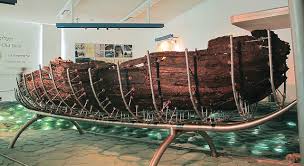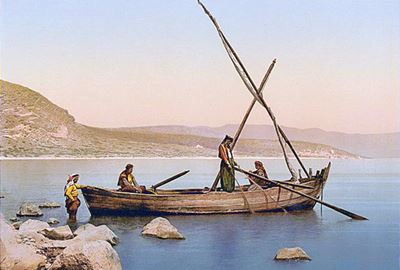Print Article
Author's Bias | Interpretation: conservative | Inclination: promise | Seminary: none
As a book of antiquity, the Bible is constantly under scrutiny for Its historical accuracy, and archeology is
used as a criterion for determining and evaluating Its trustworthiness and truth. Was Jesus a historical person?
Did the stories of His life reflect the conditions of the first century?
During the drought of 1986, two fishermen discovered a first century boat along the muddy northwestern shore of
the Sea of Galilee. The recovery process took 12 days and nights and its preservation required a seven year chemical
bath.
The dimensions of the boat's remains are in length: 9 meters (29.5 feet), width: 2.5 meters (8.2
feet) and height: 1.25 meters (4 feet).
A cooking pot found next to but outside of the boat was dated between the mid-first century B.C
to mid-second century A.D. A pottery lamp found within the boat's remains was dated within the same period. Iron nails
were also found within the boat's frame.

This was the first boat of its kind dated to the first century. Scholars believe that the boat's size was
sufficient to be a fishing or ferry boat, and its design may well be the very type mentioned in the gospels.
Now it happened that while the crowd was pressing around Him and listening to the word of
God, He was standing by the lake of Gennesaret; and He saw two boats lying at the edge of the lake; but the
fishermen had gotten out of them and were washing their nets. And He got into one of the boats, which was Simon's,
and asked him to put out a little way from the land. And He sat down and began teaching the people from the boat.
When He had finished speaking, He said to Simon, "Put out into the deep water and let down your nets for a catch."
(Luke 5:1-4)
On that day, when evening came, He said to them, "Let us go over to the other side."
Leaving the crowd, they took Him along with them in the boat, just as He was; and other boats were with Him.
(Mark 4:35-36)

Early 20th century Galilean boat
Close examination of the boat's construction indicated that, prior to the insertion of its frames, the shell of
the boat was built with planks that were joined edge to edge with pegged mortise and tenon joints. The frames were
attached to the shell with iron nails. This common Mediterranean shipbuilding method was typical for the period 100
B.C. – 200 A.D.
Lebanese cedar and oak frames were common materials; however, this boat had in addition ten other
wood species. Archeologists also found wood from ten other species, recycled wood and planks of non-uniform sizes,
which may indicate that the boat's owner could not afford the best construction materials.
The boat could easily support a square sail amidships and could be rowed with four or five oarsmen. The boat's
design does allow for one to sleep in it as well as support the transportation of Jesus and His disciples. The
existence of the boat affirms a detail in the gospel narratives adding more support to the historicity of Jesus.
The boat is available for study at the Yigal Alon Center at Kibbutz Ginosar on the Sea of Galilee.
"Walking on the water is easy to an impulsive pluck, but walking on dry land as a disciple of Jesus Christ
is a different thing."
Oswald Chambers (1917)
Copyright ©
2015
Helpmewithbiblestudy.org. All rights to this material are reserved. We encourage you to print the material for personal and
non-profit use or link to this site. If you find this article to be a blessing, please share the link so that it may rise in
search engine rankings.